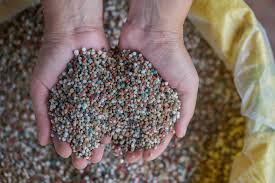
Jul . 25, 2024 08:12 Back to list
Exploring the Production Process of 12-8-16 Fertilizer Manufacturing Facilities and Their Environmental Impact
The Impact of 12-8-16 Fertilizer Factories on Agriculture and the Environment
Fertilizers play a crucial role in modern agriculture, providing essential nutrients needed for plant growth. Among various formulations, 12-8-16 fertilizers, which contain a balanced ratio of nitrogen (N), phosphorus (P), and potassium (K), have gained significant attention. This article explores the operation and significance of 12-8-16 fertilizer factories, their contributions to agricultural productivity, and the environmental considerations that accompany their use.
Understanding 12-8-16 Fertilizers
The numbers in 12-8-16 represent the percentage by weight of the three primary nutrients present in the fertilizer. Specifically, this formulation contains 12% nitrogen, 8% phosphorus, and 16% potassium. Nitrogen is vital for vegetative growth, promoting lush green foliage, while phosphorus is essential for root development and flowering. Potassium aids in overall plant health, improving disease resistance and enhancing the quality of fruits and vegetables. This balanced combination makes 12-8-16 fertilizers particularly effective for a variety of crops, including cereals, vegetables, and fruit-bearing plants.
The Role of Fertilizer Factories
Fertilizer factories play an integral role in producing 12-8-16 fertilizers. These facilities use sophisticated processes to ensure that the nutrients are available in the right ratios and forms for plant uptake. The manufacturing process involves mixing raw materials such as ammonium nitrate, superphosphate, and potassium chloride to create a homogeneous product. Advanced technology and quality control measures are essential to ensure that the fertilizer meets industry standards and is effective for agricultural use.
Moreover, the location of fertilizer factories is strategically important. By situating these facilities near agricultural hubs, manufacturers can reduce transportation costs and ensure timely delivery of products to farmers. This accessibility is crucial for maximizing agricultural productivity, especially during peak planting seasons when the demand for fertilizers surges.
Enhancing Agricultural Productivity
12-8-16 fertilizer factories

The use of 12-8-16 fertilizers has been linked to increased crop yields and improved quality of agricultural produce. By providing crops with the essential nutrients they require, farmers can achieve better growth and higher productivity. This not only contributes to food security but also enhances the economic viability of farming operations. For instance, with the application of this balanced fertilizer, cereal crops can exhibit improved grain size and weight, while fruits and vegetables can develop enhanced colors and flavors.
Furthermore, the introduction of technology in the application of fertilizers, such as precision farming tools, has made it easier for farmers to apply the right amount of nutrients at the right time. This optimization helps in minimizing waste and reducing costs, leading to more sustainable farming practices.
Environmental Considerations
Despite the benefits of 12-8-16 fertilizers, there are environmental concerns associated with their use. Over-application can lead to nutrient runoff, contaminating water sources and causing issues like eutrophication—a process that results in excessive algae growth in aquatic systems. This can severely disrupt local ecosystems and harm aquatic life.
To mitigate these environmental impacts, fertilizer factories and agricultural stakeholders must adopt sustainable practices. This includes promoting soil testing to determine the appropriate nutrient needs of specific crops and encouraging the use of controlled-release fertilizers that minimize leaching. Educating farmers on best practices for fertilizer application can also help balance productivity with environmental stewardship.
Conclusion
In conclusion, 12-8-16 fertilizer factories play a pivotal role in supporting modern agriculture by providing essential nutrients that enhance crop yields and quality. However, it is crucial to address the environmental challenges posed by fertilizer use. By embracing sustainable practices and technologies, the agricultural sector can continue to benefit from fertilizers while safeguarding the environment for future generations. Balancing productivity with ecological responsibility will be key to the future of agriculture and food security.
-
Premium Amino Acid Fertilizer | Rapid Plant Growth Booster
NewsJul.31,2025
-
10 10 10 Fertilizer Organic—Balanced NPK for All Plants
NewsJul.30,2025
-
Premium 10 10 10 Fertilizer Organic for Balanced Plant Growth
NewsJul.29,2025
-
Premium 10 10 10 Fertilizer Organic for Balanced Plant Growth
NewsJul.29,2025
-
Premium 10 10 10 Fertilizer Organic for Balanced Plant Growth
NewsJul.29,2025
-
50 Pound Bags of 13-13-13 Fertilizer for All Plants – Bulk & Organic Options
NewsJul.28,2025
